Here is something that most of you may not know about our family… My father can trace his history back to around 1648, when the first Hilmar (Hylmar) came from Swedish/Nordic territory to Košťanech (in what’s now known as the Czech Republic) as a soldier in the Thirty Years’ War. He settled and made his trade as a maker of chain mail for armor. He was a Protestant, but in order to marry he had to convert to Catholicism, which he did.
The next notable relative was František Matěj Hilmar, a noted teacher and composer.
Meet my great-great-great-great grandfather … František Matěj Hilmar.
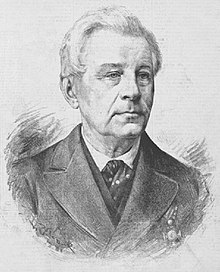
Who is he?
He’s the man who composed this (click to let it play in the background as you finish reading this post.)
Read on and learn a little bit of musical history…
At times, even we are amazed and astonished at all of the musical history and talent in our family, traceable all the way back to the early 1700’s. My great grandfather was Josef Šrámek, a musician at Dolní Krči, a town recognized since 1222.
Is it any surprise that most of us have such a musical ear and such a passion for music?
František traveled the world as a child, performing his musical compositions on the violin, harp, flute and piano for royalty and aristocrats. He became the composer of the first ever printed Polka.
First ever!
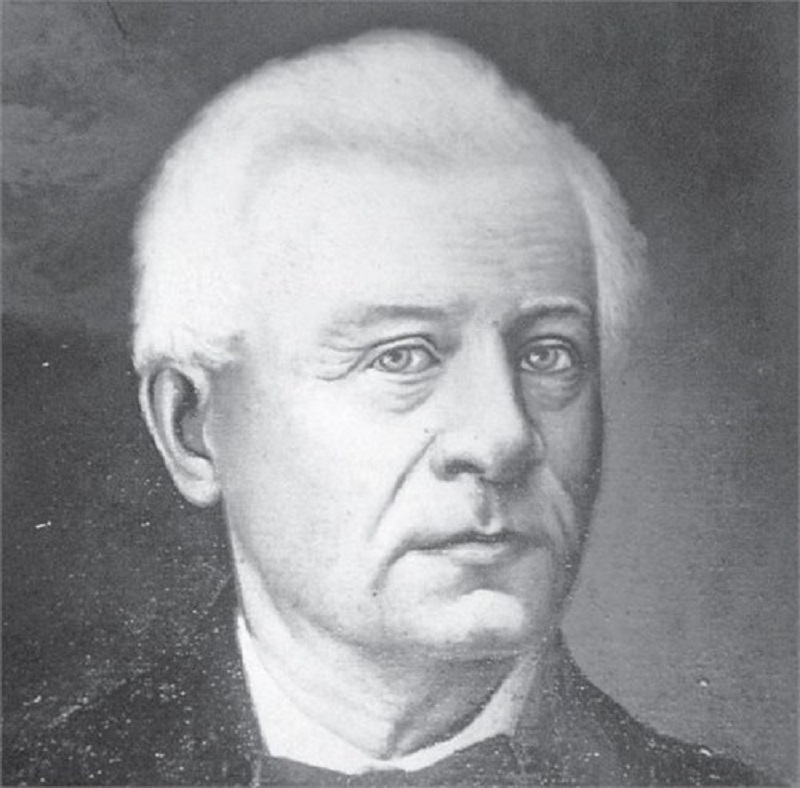
The “father” of the Polka!
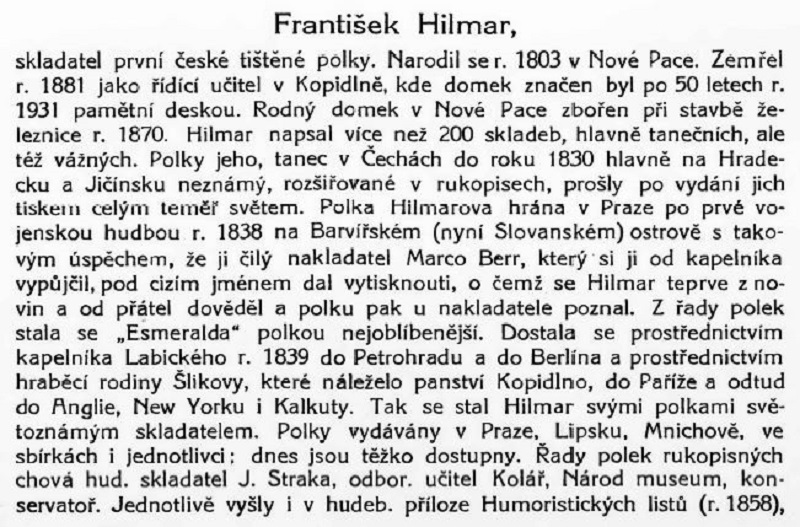

(Above from the book Novopacko. Vlastivědná monografie okresu. Díl III, by okr. školní výbor a kult. odbor učitelské jednoty “Budeč”, 1929.)
He belongs to the musical generation of Josef Labitzky who was called the “Bohemian Strauss”.
His Polkas are said to have influenced Bedrich Smetana in his younger years, as well as Antonín Dvořák.
In 1835, when the dance first appeared in Prague, it was dubbed “half” dance (half according to the rhythm), and then the name quickly changed to Polka.
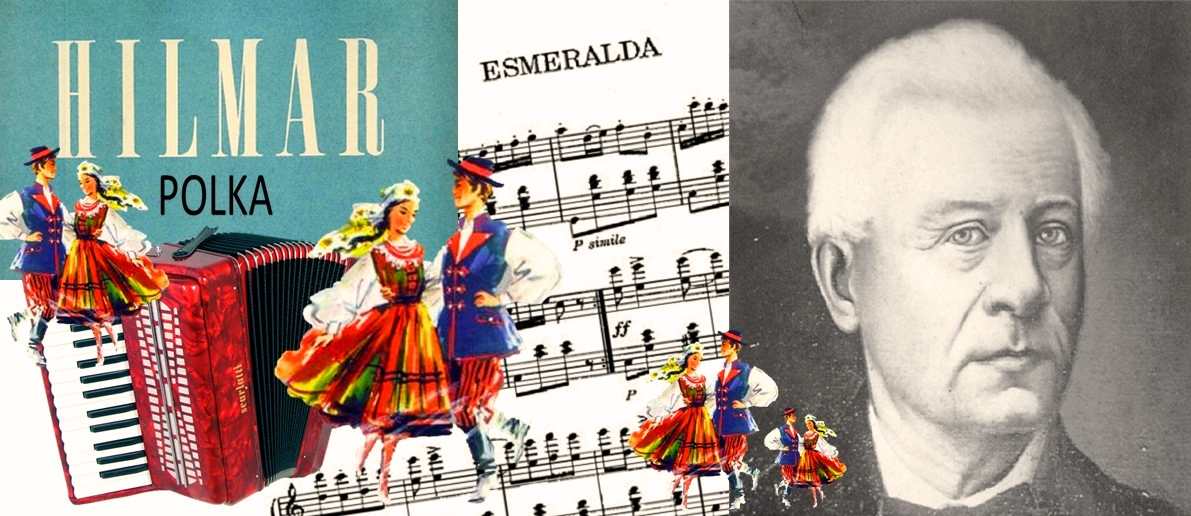
The first printed music for a Polka was for the song Esmeralda.
The following Czech text is from Podobizny I., 1873-1881 by Jan Neruda (Publication date 1951)
FRANT. HILMAR
NE — VHODNĚJŠÍ PODOBIZNU NEMŮŽEME ani v době vrcholícího se masopustu přinést než : podobiznu Hilmarovu, skladatele první tiskem vydané, v oblibu a známost celého světa vešlé polky. Jmenovala se, jakož už právě světově známo a do světových dějin na nej veselejší stránku úsměvným rubínem vepsáno: »Esmeraída«! Podivně dost přišlo to české dítě k tomu sice slušně znějícímu, takto ale pracikánskému jménu.
Stařeček František Hilmar. Skoro již osmdesátník — scházejíf mu do osmdesátky už jenom dvě léta — a napořád ještě veselý, milovník rozmarných společností, jakž ku svému potěšení z venkova se dovídáme. Tráví f dobu svého odpočinku v Kopidlně, kdež byl učitelem, a skládá napořád polky, písně a podobné veselky. Však si už odpočinku zasloužil!
Hned co hoch malý šel — v průvodu svých rodičů, novopackých osadníků, — co ilautista a pianista světem — svět se mu líbil, svět ho, milého, dobrého umělce hladil, a veselost vestěhovala se Františkovi do srdce a už ho ani víc neopustila. Co mladík šestnáctiletý byl už podučitelem, po pilném, skoro čtvrt roku trvajícím studium na preparandě — tak důkladně brala se tenkrát příprava na důležitý ovšem stav učitelský! Vzdor tomu stal se učitelem svého času proslulým, ač byl »ve všem samoukem*:, jak sám rád dosud se nazývá. V letech čtyřicátých vyznačen celému kraji co » učitel vzorný «, a zvláště s pochvalou vytknuto, že velmi obratně vyučoval »mluvnici a pravopisu českému«. Později vyznamenán záslužným stříbrným křížem s korunou. Jeho články ve vychovatelských listech byly hledány; jeho přednášky v učitelských schůzích prosluly.
A Hilmar vydržel v činnosti učitelské 54 léta — písem padesát čtyry létat Víte, co to je? — Přitom skládal pořád vesele dál, na sta polek složil a uveřejnil on sám jediný — mimo to pochody, mše, rekvie a jiné, do masopustu přísně vzato nenáležející věci. Leckteré pěkné skladby uveřejnil i v našich Humorech, když tyto měly r. 1858 také svou hudební, Zvonařem redigovanou přílohu.
Nám jde pro dnešek hlavně o to, že Hilmar jest » mistrem polky*. O jeho polkách vynešen soud: ». . . vynikají jak původní melodií, národní ráz mající, tak hlavně pravým rytmem — kterého moderním jeho stoupencům nejvíce se nedostává — slovem: Hilmarovy polky se posud nejlíp tančí, ony takřka milovníka tance elektrisují, jsouce pravými kousky »od podlahy* . . .
A především nám jde o »Esmeraldu«. To je už staré dítě, narozené v letech třicátých, ačkoli vypadá jako čerstvá, porosená růže. Přišla takto na svět: Hilmar byl dobrým tanečníkem. Přál si mít pro tanec tempo volnější, než bylo tehdejší »ekosé«, a rychlejší než »Nimra«, nový to tanec, jenž ve vůkolí kopidlanském k písničce ^Strejček Nimrá koupil šimla« polkovým krokem právě počínal se tančiti. Složil tedy také několik, avšak rychlejších »Nimer«. Jedna z nich dostala se bez jeho vědomí do Prahy vojenskému kapelníku Liemannovi a učinila na tehdejším Barvířském ostrově (Žofín) furore nesmírné. Podnikavý hudební nakladatel Hoffmann vyžádal si ji od kapelníka a zanedlouho vyšla tiskem Hilmarova »Esmeralda« — jméno to jí dáno teprve v Praze — co první česká polka. Vyšlo jí několikeré vydání, prošla celý svět a dodnes elektrisuje, zahrána na koncertním pódiu. Všude se o ní psalo a taneční mistři celé Evropy přijížděli do Prahy, aby se přiučili polce.
(If someone is willing to translate the above for us, we will be most grateful. Send it to sayhi@tresbohemes.com.
We also found the following from Beseda Ucitelská. Týdenník pro učitele a přátele školství národního, Volume: 1878, Issue: 17.10.1878.
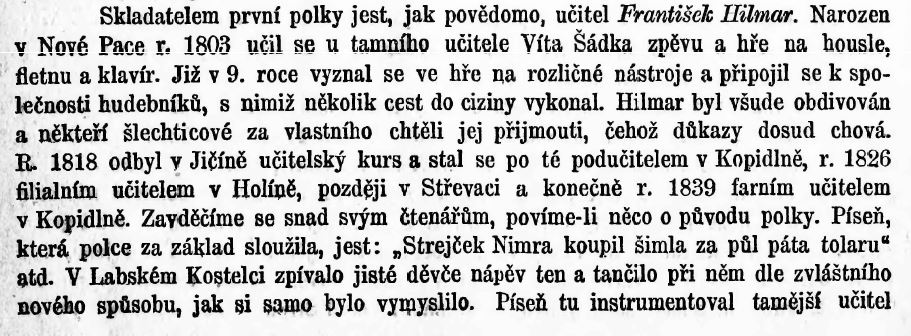
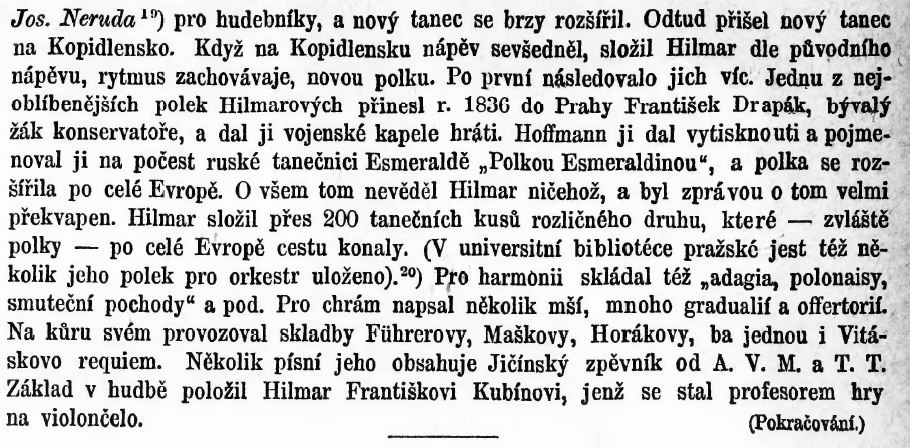
Bohemians called the new dance one “full of temperament” and it quickly spread to neighboring countries. As Czech emigrated to other parts of Central Europe its popularity spread – and later it was carried all the way to North and South America.
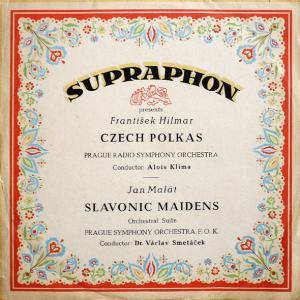
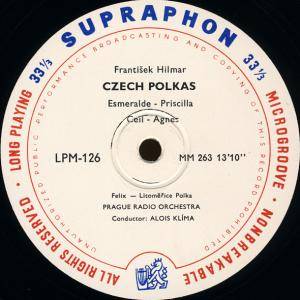
The name of Esmeralda was taken from “The Hunchback of Notre-Dame” by Victor Hugo. Esmeralda is an intelligent and ravishingly beautiful gypsy and she is the only friend of the ugly hunchback named “Quasimodo”.
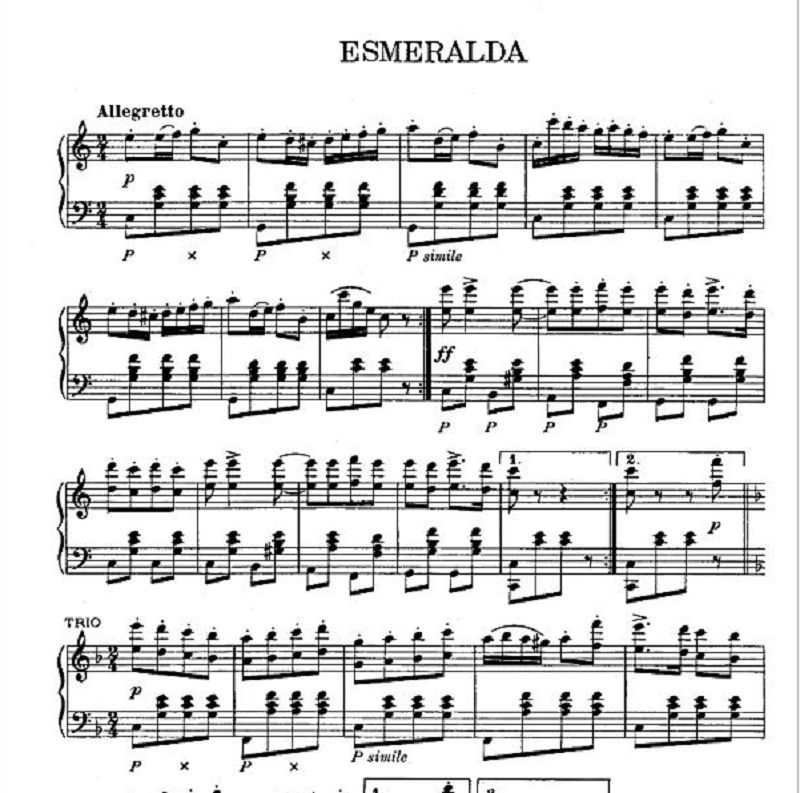
The polka is a Central European dance and genre of dance music familiar throughout Europe and the Americas. It originated in the middle of the 19th century in Bohemia, now part of the Czech Republic.
Polka remains a popular folk music genre in many European countries, and is performed by folk artists in Germany, Austria, Czech Republic, Croatia, Slovenia, Switzerland, and, to a lesser extent, in parts of Poland, Latvia, Lithuania, Netherlands, Hungary, Italy, Ukraine, Romania, Belarus, Russia, and Slovakia. Local varieties of this dance are also found in the Nordic countries, United Kingdom, France, Ireland, Latin America, the French Antilles and in the United States, especially states with a strong Czech population like Texas, Nebraska and Oklahoma.
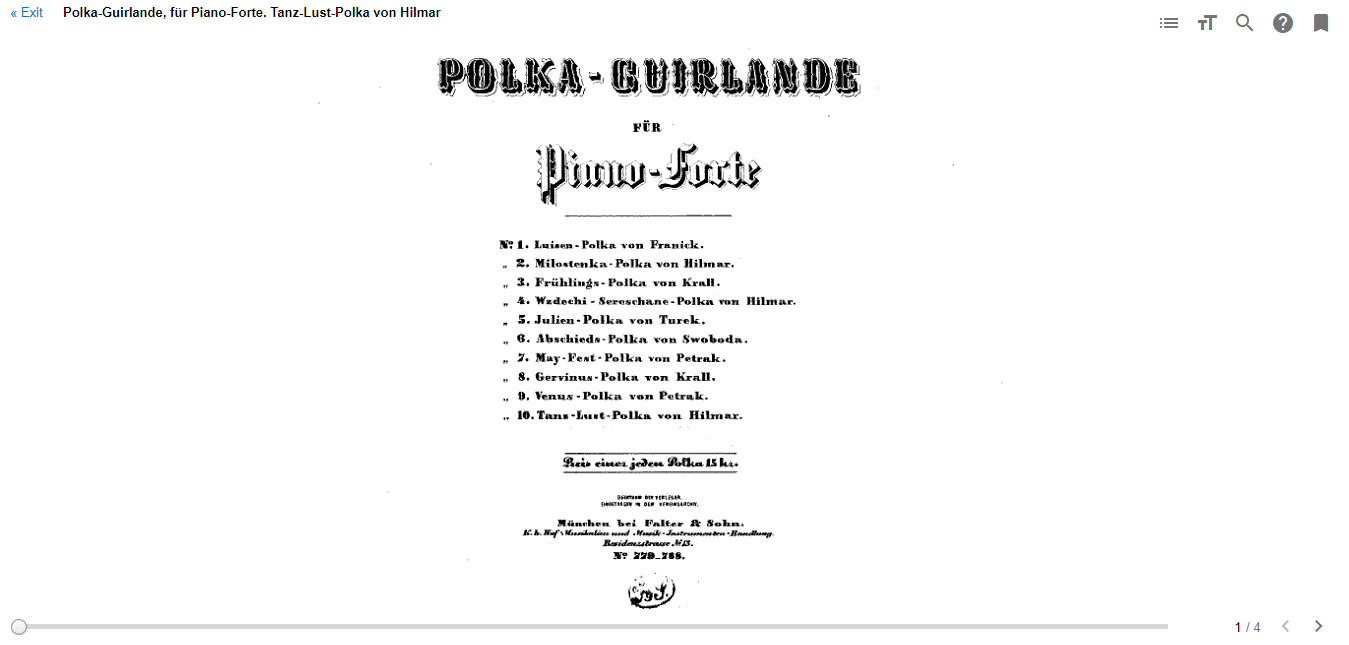
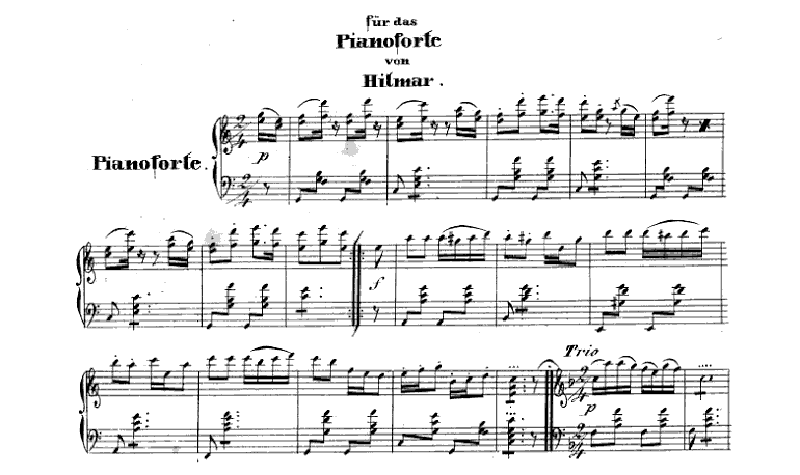
The name polka possibly comes from the Czech word “půlka” which literally mean half, referring to the short half-steps featured in the dance.
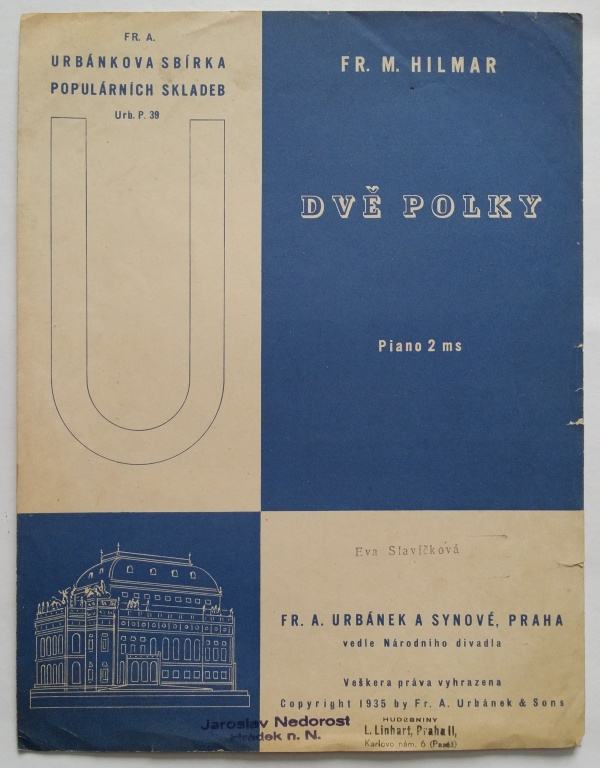
The Czech cultural historian and ethnographer Čeněk Zíbrt, wrote in detail about the origin of the dance, in his book, Jak se kdy v Čechách Tancovalo. He cites that “polka” was supposed to mean “dance in half” (“tanec na polo”) i.e. the absence of diacritics, both referring to the half-tempo and the half-jump step of the dance. The word was widely introduced into the major European languages in the early 1840s.
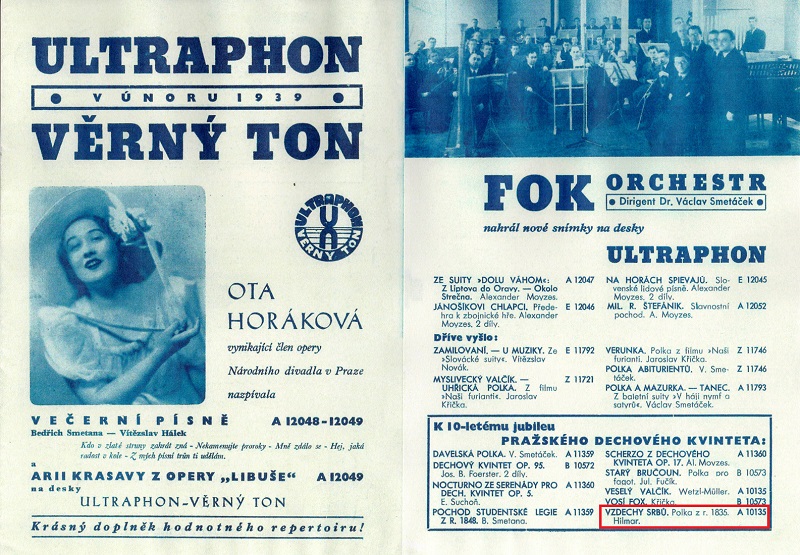
Hilmar composed over 200+ dances, especially polkas, but also galopades, waltzes, contemporary dance music and even sacred music. He wrote at least three Masses and many other occasional pieces for church purposes.
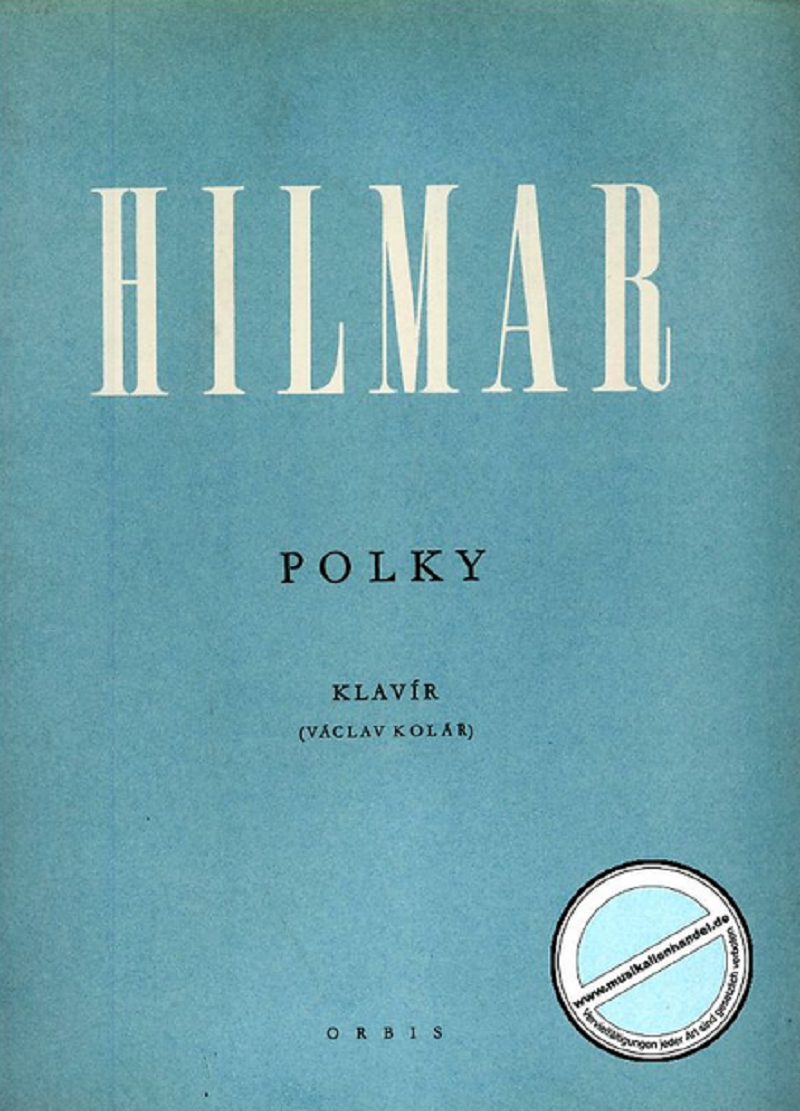
In our native Czech Republic there is an entire square named after him. In fact, if you walk through the small town of Kopidlno, you will encounter many places that still carry the name of this important musician, dancer and composer of the first printed polka.
Whether you go Hilmarovou ulicí (Hilmarovo Street), across Hilmarovo náměstí (Hilmarovo square), when you stop at the statue of Christ with the cross on the grave of František Matěj Hilmar (Francis Mathew Hilmar) or you read the text of a commemorative plaque at the artist’s house – everywhere the name of the author will still speak to you, the composer whose polkas still appeal to listeners around the world.
František was born on September 30, 1803, part of a rather poor family in the city of Nova Paka. This is a mountainous region home to semi-precious stones, potatoes, and flax. His parents had a small farm and a bakery. (Many bakers and bakeries in our family tree as well!)
His childhood summers were spent at home, where he attended elementary school and where he learned to play the violin, harp, flute and piano from teacher Vitus Sadko.
By the age of nine, he had mastered the instruments and was taken to perform through Liberec, Zittau and Dresden to Austria, Poland and Russia.
Playing the piano (a libozněn as it was then called) was very popular at the time, especially among nobles. Since most players were amateurs, František was often called upon because he was one of the few who could play and thus he performed for these families, often generously endowed for his efforts.
He was thirteen years old when he left Nova Paka for good and toured even further in Europe. He traveled to Russia, Germany, Poland and other countries where excellent Czech musicians were welcome.
Despite his young age, he was recognized as the leader of the other musicians he traveled and toured with. His older colleagues had to often protect him from royalty that wanted to keep him for themselves because of his musical talent and they often attempted to “buy” him with offers of higher musical education and the royal amenities of a noble life.
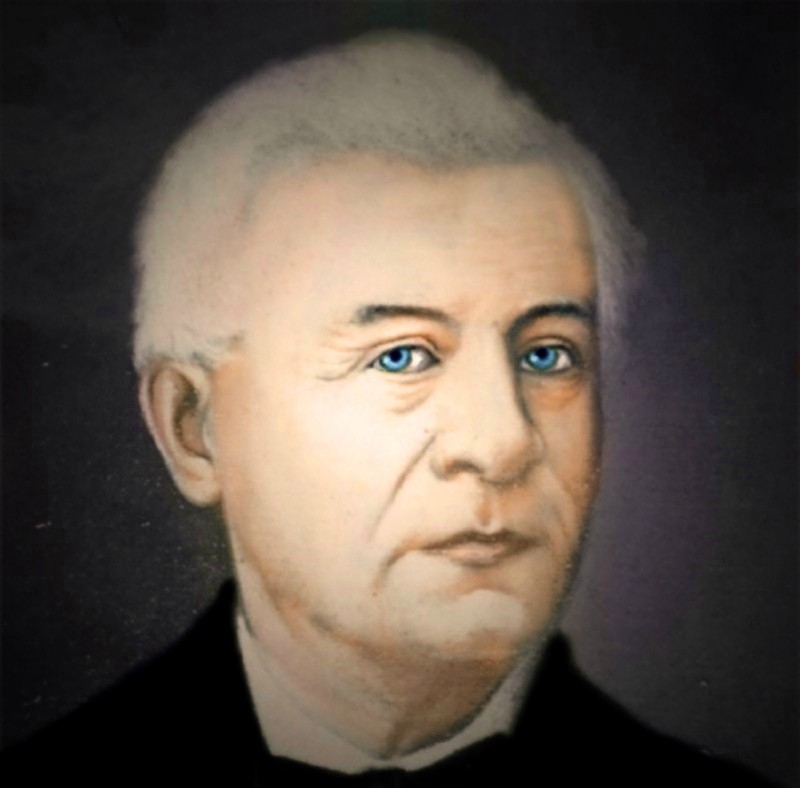
But František was loyal to his family, his town and his roots and after several years, he returned to his homeland and afterwards remained faithful to the Nova Paka area, especially Kopidlno until the end of his life.
Hilmar lived in a modest house for more than half a century. The little cottage squeezed between other homes at 180 Hus Street in Kopidlno later sheltered four Hilmar family members, a piano and necessary household equipment into two tiny rooms. When you look at it, you can hardly believe it to be true – but it is.
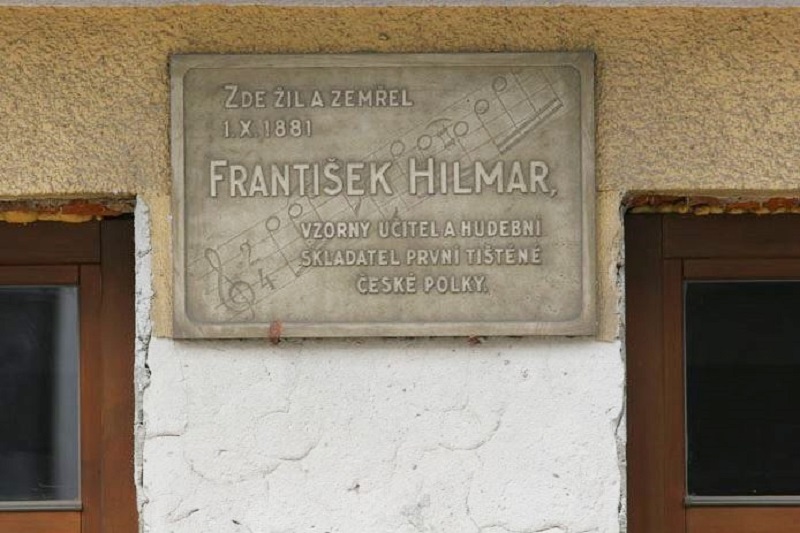
He was a man who had an extreme passion for teaching, who focused on the future generations and whose genius was brushed off as not so important.
The house still stands.
A marble plaque on the facade of the household indicates that František Hilmar lived here, a model teacher and composer of the first printed polka.
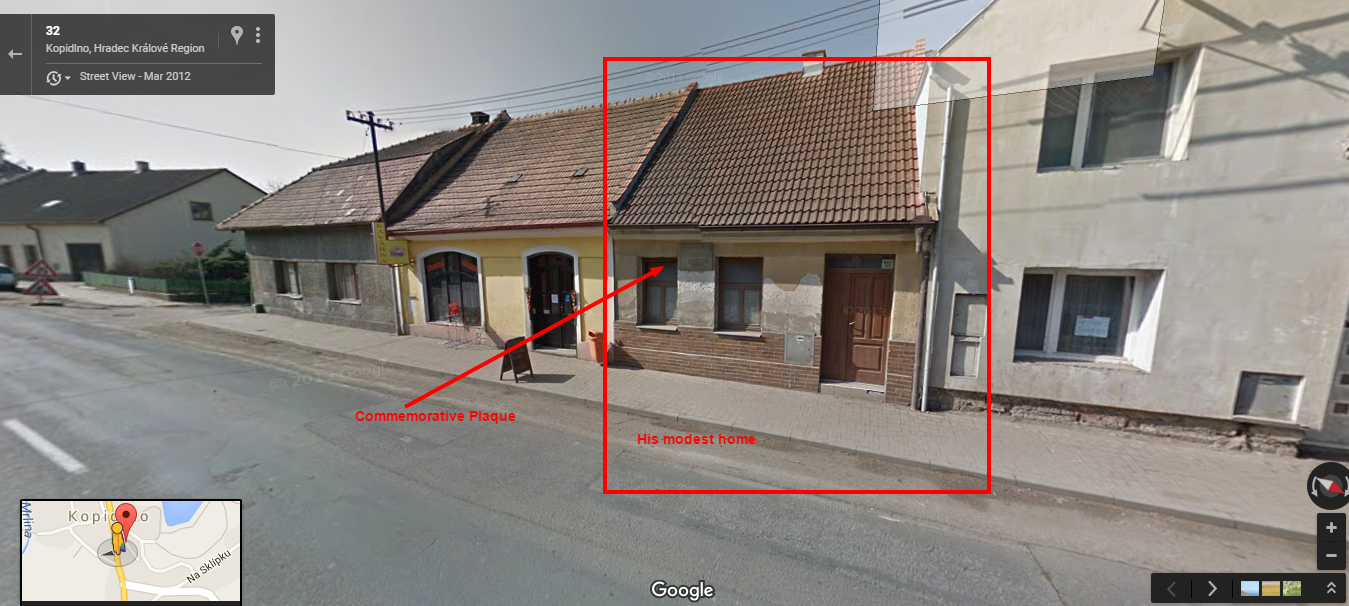
And throughout that time, he chose to live simply and he worked tirelessly as a pedagogue.
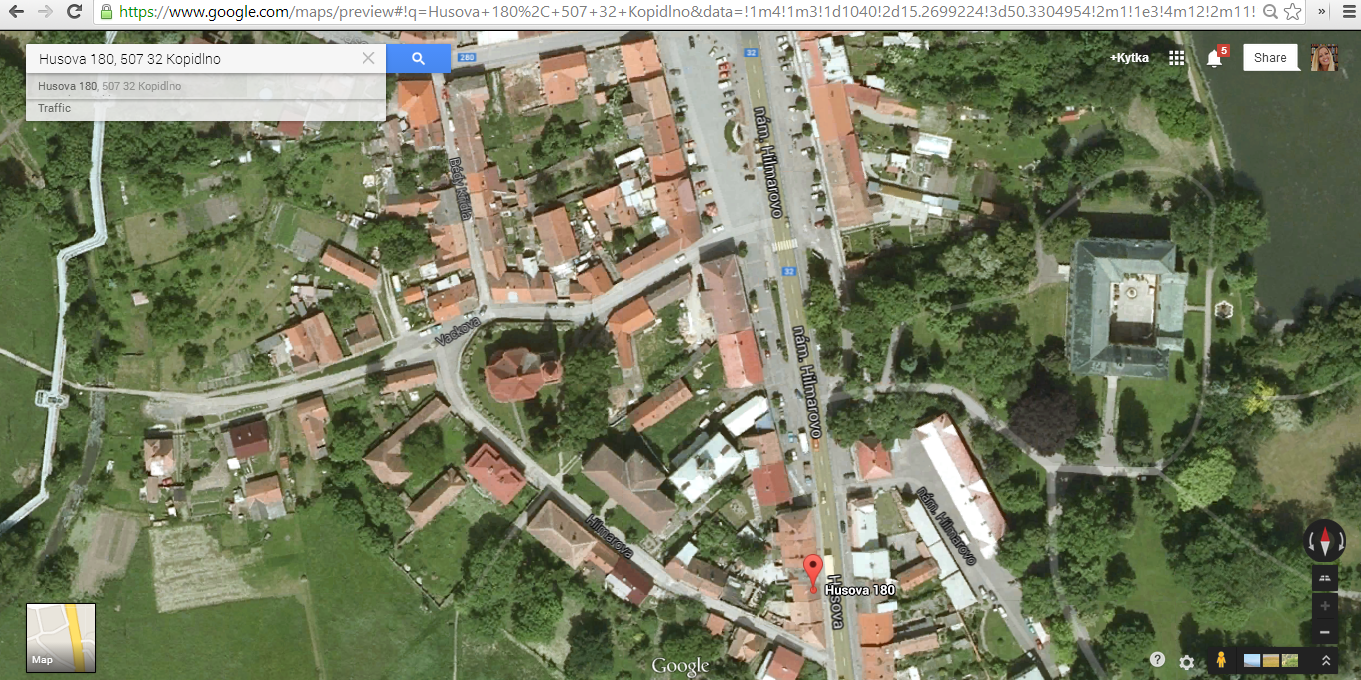
His extraordinary musical talent was immediately perceived by the local parish priest F. A. Vacek (friend Jungmann and Dvorsky) who asked Hilmar if he would consider being a teacher. František accepted the offer and began to attend several weeks teaching a course in nearby Jičín.
Always considerate of helping his parents, and they to support his music, they all worked together so there would be enough money necessary for him to study music. His first position was as a teaching assistant at a school in Kopidlno.
Later he served as the branch teacher in Cologne and in Střevač, but in 1838 he returned back to the school in Kopidlno, where he spent a full 35 years.
František respected his position and was constantly aware of the importance of education. Besides music, he taught English and spelling, which became his favorite subject.
During his life, teaching played a profound part, encompassing a full fifty-year span and influence. In fact, he was such a well respected pedagogue that he was awarded the silver cross with a crown.
He loved his people (Czechs), not only at work or in his teaching practice, but also in his compositions. That is why his music literally breathes the “right (correct) Czech national spirit”. And because of that, his polka became the Czech national dance. It’s sound, timing and movement captured the spirit of the Czech people. It spread from his little village and the Czech countryside all the way to Prague and was played at representative balls and concerts.
But the whole world was ready to listen to the change…
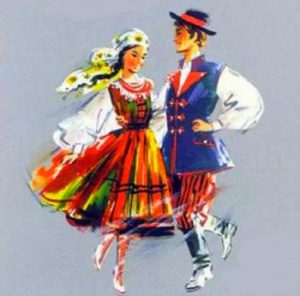
Hilmar’s polka penetrated further into Vienna and then conquered Paris. It was presented on the stage of the theater in Milan, Italy, and from there spread to Germany.
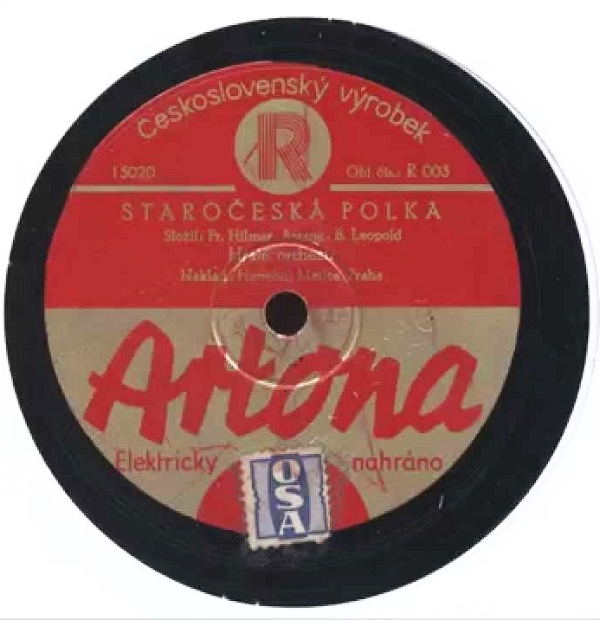
Over the course of his lifetime, František composed over 200 dances, especially polkas. And those are the ones we know of. Some say that there were many, many more that were not discovered or that aging lost forever.
He distributed his works in copies to everyone who asked or was interested.
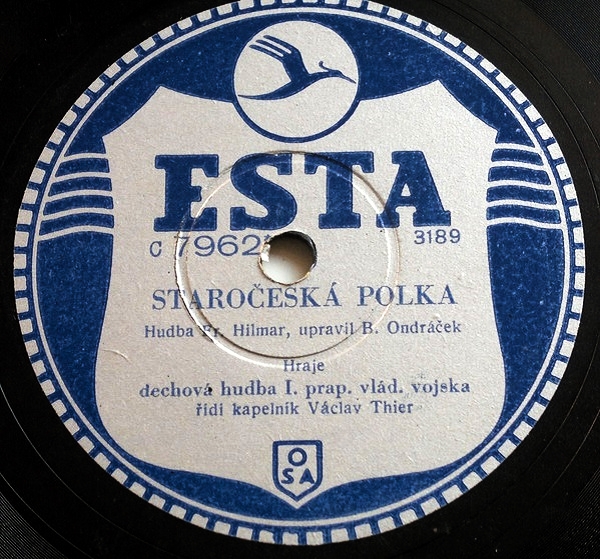
The tragic fact is that living in his small town and focused on teaching, he was quite unaware that his music was even printed, published and taken around the world. More entrepreneurial and business minded individuals profited from his creations and often times he was never even properly credited.
It would be a great undertaking to visit the archives in the Czech Republic and begin to search for all his music (though a task we would absolutely love to take on if we had the necessary funding)!
The polka Esmeralda is what brought him to the international spotlight. Esmeralda won over the world. Its text appeared in Paris, and even in America.
He also had great success with his other polkas, namely Gypsy, Amateur, Dahlia, A Patriot, Staročeská Polka, Terezie, Felix, Eliška. Polka pro klavír na 2 ruce, Camelia, Masurek, Cossack, Louis Waltz, Favorite Polka; Gallop, Ernestine Polka, Hradec Kralove, Mariánské Lázně Polka, Karlovy Vary Polka, Teplitz Polka, Hortensia polka, Priska Polka (La Coquette), Guido-Gallop, Cecilia polka, Mazurka, Kunigunde polka, Agnes-Polka, Vlastenka, Jiřinka, Werrrennen, Albertinen Galopp, Zigeuner, and others that are still playing and dancing wherever Polkas are played.
I wonder if Texas Czechs play his music?
Next time we are there we will have to inquire.
Meanwhile – I’m looking for sheet music or recordings. If you have them or know anyone who does – please contact us!
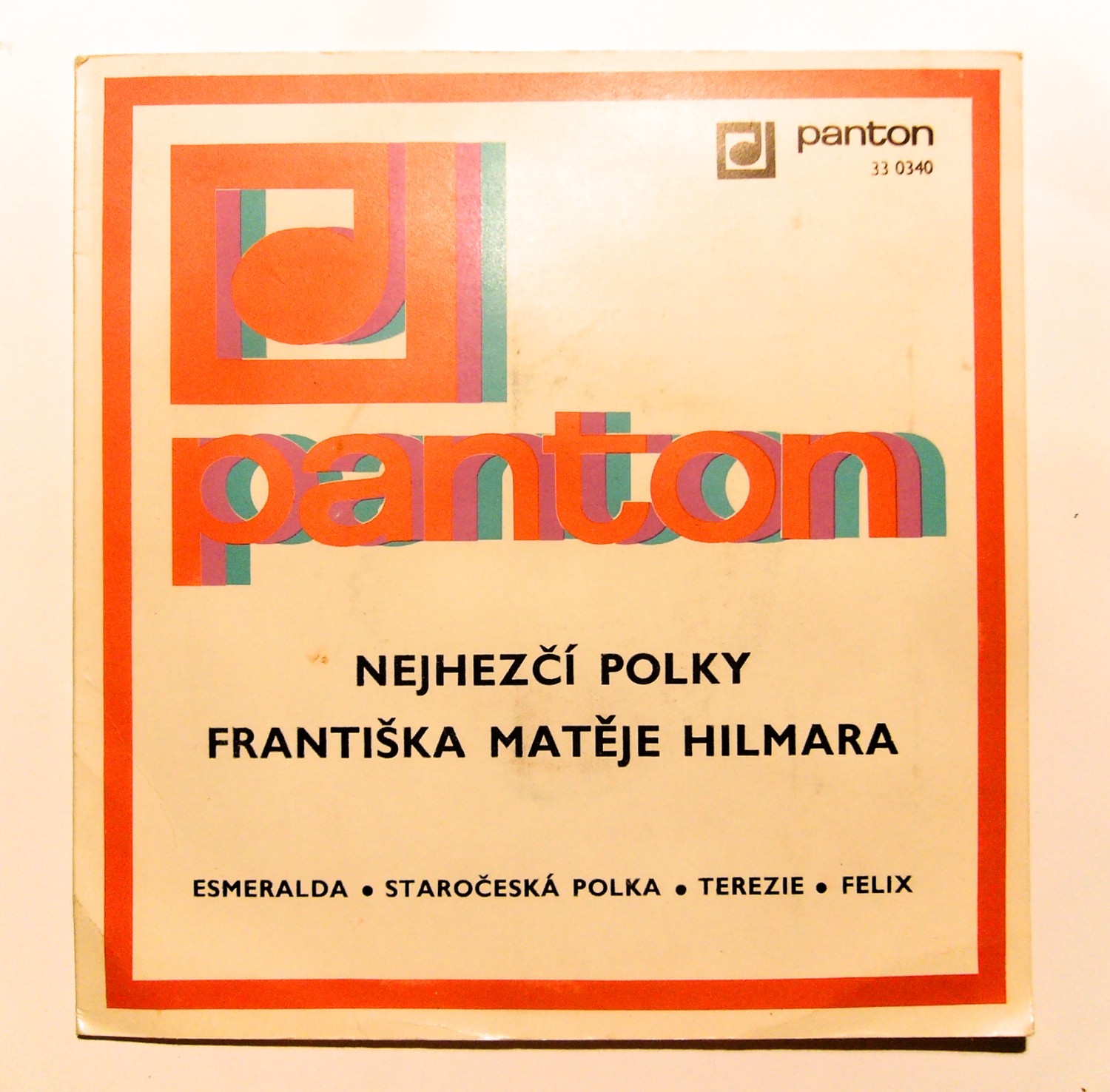
People danced, marched and worshiped to his tunes and based on the artistic level of his songs, even greats such as Bedrich Smetana and Antonin Dvorak exclaimed a great appreciation towards Hilmar’s compositions. They held him as a peer and regarded the composer’s work in the highest esteem.
Aside from his musical talents, he was also known as a very good dancer, and it is said that this is why he was a natural at creating Polka’s half time rhythm. Hilmarova Polka’s are regarded as truly Czech jewels, they are musically sweet and simple while beckoning his smartness and originality.
The popularity of Polkas spread and they were danced not only in cities but also in every hamlet. In the 1940’s many publishers decided to print and publish Hilmar’s works because it seemed that after WWII the world was ready to dance.
Purely sincere, joyous and lively, sounding honest and real, the heart and soul of Czech folks was embued all over the world and won the hearts of people everywhere.
Hilmar spent most of his days at school. You could often find him in the school garden where he was a passionate beekeeper. After coming home from school he would work at his school assignments and devote his evenings to preparing for the next school day. Then he would sit down at the piano or with the violin and make music to relax and unwind.
When he did this, he always made sure to have manuscript paper, quills and ink. He would work a piece of music, and if he liked it, he would write it down immediately.
In addition to these works he also taught music, and oftentimes he would bring the best students home to continue lessons and to play music together. Much time was spent practicing with his musician students, and they would create secular music to perform and play at the church.
Throughout his life he played so well it is no wonder that when he went abroad he was surrounded by nobles and lords, all continuously wanting him to leave his little cottage, leave his teaching position and his home.
He never did. He was committed to his family and his roots.
Perhaps the greatest public honor and tribute he received was when Zdenek Nejedly, author of a book about Bedrich Smetana wrote: “And so, Smetana grew up under the influence of the first and best polkas by František Matěj Hilmar.
Listen to his music…
We think it’s pretty darn awesome that there is a Hilmar Square in the town to commemorate his musical genius and contributions.
nám. Hilmarovo
507 32 Kopidlno
Czech Republic
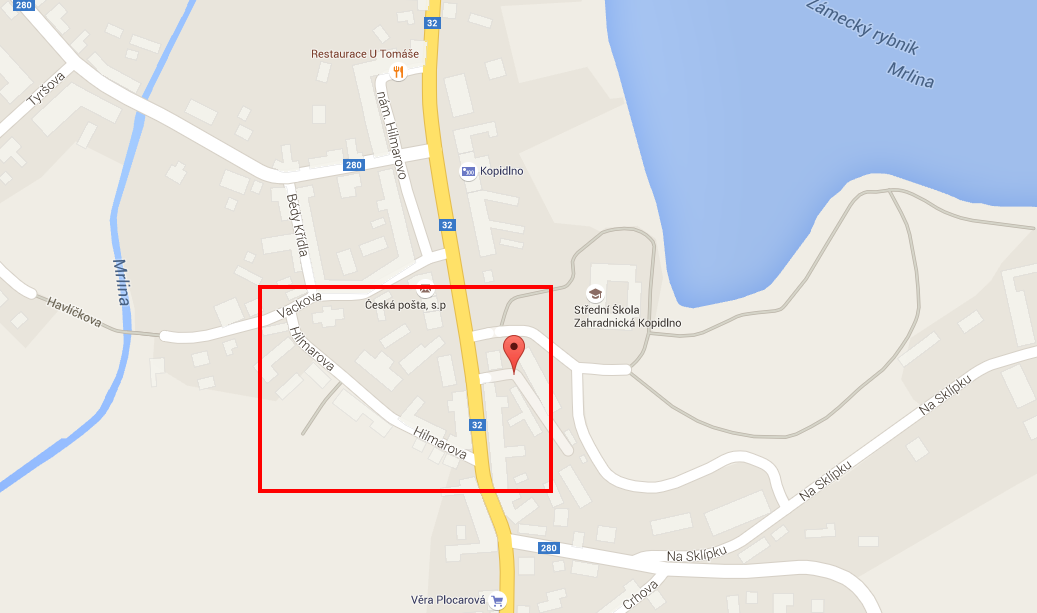
They have an annual parade and when we were in Prague they asked us to come back in the summer be a part of it! Unfortunately, we were not there in the summer but maybe one day…
Until then, we can only see the angel that watches over him at his grave…
Rest in Peace ancestor Hilmar…
And thank you for your beautiful music that you contributed to the world.
Sources: Wikipedia, Kopidlno, Infoglobe, Wikiwand, Lidkovy, Digital Library, Rundel, RadioCZ,
(Notes: Ziegeuner Polka ; Masureck ; Cosaken Polka ; Louis Walzer ; Favorit Polka ; Galopp from Nachklänge von Warmbrunn: für Piano-Forte.)
* * * * *
Thank you in advance for your support…
You could spend hours, days, weeks, and months finding some of this information. On this website, we curate the best of what we find for you and place it easily and conveniently into one place. Please take a moment today to recognize our efforts and make a donation towards the operational costs of this site – your support keeps the site alive and keeps us searching for the best of our heritage to bring to you.
Remember, we rely solely on your donations to keep the project going.
We appreciate you more than you know!
If you have not already subscribed to get TresBohemes.com delivered to your inbox, please use the form below now so you never miss another post.

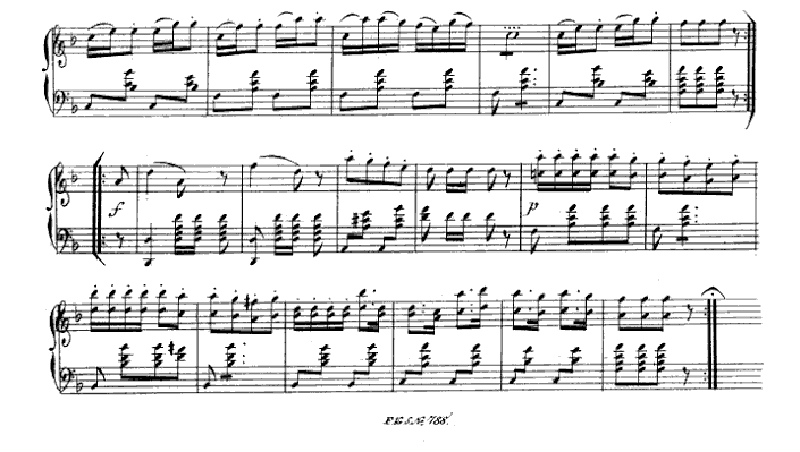





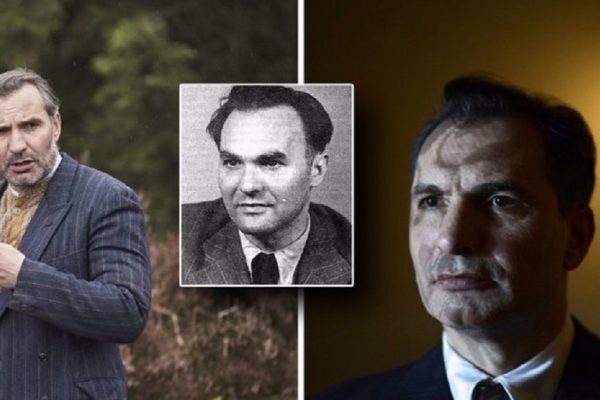















Very nice Kytka to know the story of your family.
Thank you Vanda!
:)
Thanks, nice music and nice blog post. good stuff
My folks raised me up on polka. Thanks for the history lesson.
I love polka. How fortunate you are to have this in your family history.
Excellent post. How lucky you are Kytka, to have such a rich family history. This is most certainly why your parents and children are also so musical because I have seen your videos on YouTube. I wonder, do you play any instruments or sing? I believe the talent is in your Hilmar blood.
Hello! I’ve been reading your website for a while now and finally got the bravery to go ahead and give you a shout out from Porter, Texas! Just wanted to tell you keep up the fantastic work!
It’s strange he does not show up in the normal historical write ups about Polkas. Why was he omitted? Is it possible such old Czech history was lost or suppressed behind the Iron Curtain? You should write a book of his music and influence, of his life.